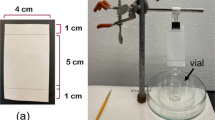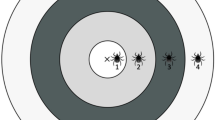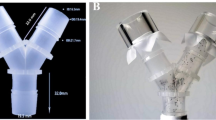Abstract
In our search for tick repellents of plant origin, to be used as alternatives to commercial arthropod repellents, we investigated the effect of the well known plant signaling compound methyl jasmonate (MJ) using nymphs of the tick Ixodes ricinus. In laboratory tests, pieces of cloth with MJ at 0.075, 0.15, 0.30 and 0.75 mg/cm2 yielded increasing repellencies against the nymphs: 57%, 71%, 92% and 99%, respectively, of the nymphs did not cling to the cloth. Repellency of MJ was also investigated in a tick-infested woodland area in central Sweden. Cotton flannel cloths sprayed with 0.05, 0.1 or 0.2 mg/cm2 MJ dissolved in acetone were dragged over the ground vegetation. The numbers of nymphs on the treated cloths were significantly lower than those on the untreated cloth. Thus, MJ has, at the concentrations tested, significant repellent activity against I. ricinus nymphs.
Similar content being viewed by others
Avoid common mistakes on your manuscript.
Introduction
The common tick Ixodes ricinus has a wide geographical range, from Ireland in the west to the Ural mountains in Russia in the east, and from Scandinavia in the north to Morocco and Egypt in the south (Daniel et al. 1998; Estrada-Peña 1999). This tick species plays an important role as a vector of pathogens to humans and domestic animals. Pathogens vectored by I. ricinus include piroplasms (Babesia spp.), spirochaetes (Borrelia spp.), rickettsia (Anaplasma spp. and Rickettsia spp.) and viruses (tick-borne encephalitis and louping ill viruses). Tick control is based, to a large extent, on the use of acaricides. The evolution of resistance of ticks to available synthetic acaricides in many parts of the world has become a problem (Nolan 1990; George et al. 2004; Graf et al. 2004) but has also stimulated research on alternative, environmentally more suitable and less expensive methods for tick control. Plant-derived natural repellents and plant-derived biopesticides could, especially if they have a pleasant smell to humans, become such alternatives to synthetic repellents and acaricides. Several methods have been proposed for evaluating repellents, which may be applied to the skin or clothing to protect an individual from tick bites (Barnard 2000).
It is known that volatile compounds play a role in plant-plant communication (Bruin and Dicke 2001). Many predatory and parasitoid arthropods use such plant volatiles, induced by herbivore attack to locate their prey. Such plant volatiles may be blends of many compounds, so it is often unknown which compounds in such a complex blend represent the signal to the food-seeking carnivore (De Boer and Dicke 2004).
Methyl jasmonate (MJ) is a naturally occurring growth and development regulator in plants (Vick and Zimmerman 1984; Berger 2002). This compound which is a volatile derivative of jasmonic acid is present in flower volatiles of many species of higher plants and is described as a pleasant smelling constituent of the essential oils of Jasminum grandiflorum and Rosmarinus officinalis (Creelman et al. 1992). MJ has been mainly studied in relation to phytophagous pest control (Birkett et al. 2000; Slesak et al. 2001; Ibrahim et al. 2005; James 2005) and it has been shown that MJ induces the formation of traumatic resin ducts in conifers (Franceschi et al. 2002). We are not aware of any previous investigation concerning the effect of MJ on ticks. The main aim of this study was to evaluate the potential activity (repellency, attractancy or other behavior) of MJ on the nymphal stage of I. ricinus.
Materials and methods
Laboratory bioassays
Nymphs of I. ricinus were collected in the field at Alsike, about 10 km south of Uppsala, east-central Sweden by dragging a light flannel cloth (1 × 1 m) over the vegetation. Nymphs attaching to the cloth were handled with soft forceps and put into marked tubes. They were kept in plastic bags supported with wet tissue papers. The nymphs were maintained in complete darkness at 4°C and 80–95% relative humidity until they were used in laboratory experiments.
Methyl jasmonate (Aldrich, 95% purity) was tested, in different concentrations, using one unfed I. ricinus nymph in a Falcon™ vial in each replicate. The Falcon vial is a 50 ml centrifugal tube, 116 × 29 mm, made of transparent plastic. To prevent saturation of the air with odor of the experimenter, test substance or control, the wall of the tube was perforated with small holes. 100 μl of 0.5%, 1.0%, 2.0% and 5% MJ (diluted in 1, 2-propanediol) were applied to circular (6.6 cm2) cotton cloths, and left to dry before each test. The final concentrations of MJ on the cloths were 0.075, 0.15, 0.30 and 0.75 mg/cm2. Each cloth was attached with a rubber band to the open upper end of a Falcon vial. Nymphs were first tested with the untreated control for 5 min and then with the test substance, i.e., the treated cloth for 5 min. To simulate host stimuli to attract the nymphs the same observer held her palm tight to the outside surface of the cloth. For a tick to be regarded as ‘attached’ to the cloth it had to detach all its legs from the vial’s surface. Ticks that were clinging to the cloth were recorded in the protocol as ‘attracted’ while ticks that did not were recorded as ‘repelled’. The results at 5 min from start of each test were used in the analyses. The procedure was repeated 10 times on the same cloth. Five cloths were used for each concentration tested.
Field study
In order to evaluate the repellency of methyl jasmonate on I. ricinus under field conditions, cloth-dragging trials were conducted at Alsike (Sweden) during mid-June 2005 for 5 days and during June 2006 for 2 days. Each cloth was sprayed with 10 ml of the test substance to cover the whole downward surface of the cloth. The final concentrations of MJ on the cloths were 0.05, 0.1 and 0.2 mg/cm2 (diluted in acetone). Two persons pulled the cloths on 5 days with the three concentrations in 2005, and on 2 days with 0.1 mg/cm2 in 2006.
Moreover, on each test day one control cloth (treated with 10 ml of acetone) was used. Each white flannel cloth, 1 × 1 m, was attached to a 1 m long wooden pole to both ends of which a cord was tied. During the experiments the cloths were pulled with the treated side downwards, towards the ground vegetation, to maximize the effect of the treatment. The control cloth was pulled in the same way, parallel to and about one meter apart from the treated cloth. The cloths were pulled slowly over an area of 10 m2 before they were inspected and each tick counted, removed and put into marked vials. This procedure was repeated 30 times per day for each substance and the control. Temperature and humidity were recorded every day before and after the test. The cloths were stored separately in airtight plastic bags until the next day of testing.
Statistical analysis
In the field and laboratory experiments the repellency was calculated using the following formula: % repellency = [(no. of nymphs on control − no. of nymphs on test)/no. of nymphs on control] × 100 (Sharma and Ansari 1994). In the field and laboratory experiments the statistical procedures generally performed here are those adapted for distribution-free or non-parametric data. We used the Kruskal–Wallis test for comparisons between substance and tick numbers. For the data of the laboratory test we used McNemar’s change test.
Results
Laboratory study
With MJ of 0.075, 0.15, 0.30 and 0.75 mg/cm2 the repellency was 57%, 71%, 92% and 99%, respectively. The McNemar’s test shows significant differences among all concentrations of MJ and the controls (Table 1). All concentrations were effective up to 30 min. With 100 μl of 100% 1,2-propanediol, i.e., 15 mg/cm2 nearly all nymphs attached to the cloth at 5 min, a result similar to that of the control (Table 1). This suggests that 1,2-propanediol does not exert any repellent activity against I. ricinus nymphs.
Field study
Methyl jasmonate at 0.05 mg/cm2 was tested for 1 day and exhibited a repellency of about 51% against I. ricinus nymphs. The Kruskal–Wallis test shows a significant difference (P < 0.01, N = 60) between the mean number of nymphs on a treated cloth with MJ at 0.05 mg/cm2 and the control cloth (Fig. 1).
Methyl jasmonate at 0.1 mg/cm2 was tested for 2 days in 2005. The observed difference between numbers of ticks on MJ-treated and untreated cloths were not statistically significant (P = 0.14, N = 120). In view of this unexpected result the test was repeated in June 2006, when the observed difference was significant (P < 0.001, N = 120) (Fig. 2). The repellency was 55% on the first day of testing and 33% on the next day.
MJ was also tested at 0.2 mg/cm2 for 2 days in June 2005. The number of nymphs recorded from the treated cloths and the control cloth was significantly different (P < 0.0001, N = 120; Fig. 3). At the highest treatment level the repellency was 80.9% on the treatment day and declined to 28.5% on the day after treatment.
Discussion
In the last decades, plant extracts have been widely used to control phytophagous and other undesired insects such as mosquitoes (Arnason et al. 1987; Koul and Dhaliwal 2001). Many of the compounds biosynthesized by plants play a role in chemical defense against insects and mites. MJ acts as a volatile plant hormone potentially mediating interactions between plants by inducing the biosynthesis of compounds. It reduces damage by herbivores and acts as a cue to other plants to signal attack by herbivores. Free-moving aphids avoid plants that have been exposed to MJ, and the effect lasted at least 24 h (Slesak et al. 2001). MJ treatment reduces the growth rate of moth larvae, Plutella xylostella L. on cabbage, Brassica oleracea (Ibrahim et al. 2005). The pine weevil Hylobius abietis L. avoids feeding on conifer twigs to which MJ is applied (A.K. Borg-Karlson, unpublished). Another study showed that MJ treatment induces increased densities of defense-related glandular trichomes on new leaves of tomato Lycopersicon esculentum (Boughton et al. 2005). MJ also induces extensive biochemical and anatomical changes in Norway spruce, Picea abies, similar to those caused by pathogens or artificial wounding (Franceschi et al. 2002).
Our aim with this study was to evaluate the potential of MJ for tick control. The results demonstrated that in the laboratory, MJ exerted significant repellent activity against nymphs of I. ricinus at concentrations between 0.05 mg/cm2 and 0.75 mg/cm2. Also in the field, MJ at 0.05 to 0.2 mg/cm2 exhibited a significant degree of repellency. In the laboratory the repellent effect of MJ was stable for at least 30 min. In the field, MJ on blankets started to lose its effect within 1 h. Therefore, in order for MJ to be used as an effective tick repellent it needs to be formulated so that its duration of activity is extended.
References
Arnason JT, Philogene BJR, Donsko N, Kubo I (1987) Limonoids from the Meliaceae and Rutaceae reduce feeding growth and development of Ostrinia nubilalis. Entomol Exp Appl 43:221–226
Barnard DR (2000) Repellents and toxicants for personal protection. WHO/CDS/WHOPES/GCDPP/2000.5. 48 pp
Berger S (2002) Jasmonate-related mutants of Arabidopsis as tools for studying stress signaling. Planta 214:497–504
Birkett MA, Campbell CA, Chamberlain K, Guerrieri E, Hick AJ, Martin JL, Matthes M, Napier JA, Pettersson J, Pickett JA, Poppy GM, Pow EM, Pye BJ, Smart LE, Wadhams GH, Wadhams LJ, Woodcock CM (2000) New roles for cis-jasmone as an insect semiochemical and in plant defense. Proc Natl Acad Sci USA 97:9329–9334
Boughton AJ, Hoover K, Felton GW (2005) Methyl jasmonate application induces increased densities of glandular trichomes on tomato, Lycopersicon esculentum. J Chem Ecol 31:2211–2216
Bruin J, Dicke M (2001) Chemical information transfer between wounded and unwounded plants: backing up the future. Biochem Syst Ecol 29:1103–1113
Creelman RA, Tierney ML, Mullet JE (1992) Jasmonic acid/methyl jasmonate accumulate in wounded soybean hypocotyls and modulate wound gene expression. Proc Natl Acad Sci USA 89:4938–4941
Daniel M, Kolar J, Zeman P, Pavelka K, Sadlo J (1998) Predictive map of Ixodes ricinus high-incidence habitats and a tick-borne encephalitis risk assessment using satellite data. Exp Appl Acarol 22:417–433
De Boer JG, Dicke M (2004) The role of methyl salicylate in prey searching behavior of the predatory mite Phytoseiulus persimilis. J Chem Ecol 30:255–271
Estrada-Peña A (1999) Geostatistics as predictive tools to estimate Ixodes ricinus (Acari: Ixodidae) habitat suitability in the Western Palearctic from AVHRR satellite imagery. Exp Appl Acarol 23:337–349
Franceschi VR, Krekling T, Christiansen E (2002) Application of methyl jasmonate on Picea abies (Pinaceae) stems induces defense-related responses in phloem and xylem. Amer J Bot 89:578–586
George JE, Pound JM, Davey RB (2004) Chemical control of ticks on cattle and the resistance of these parasites to acaricides. Parasitology 129(Suppl):S353–S366
Graf JF, Gogolewski R, Leach-Bing N, Sabatini GA, Molento MB, Bordin EL, Arantes GJ (2004) Tick control: an industry point of view. Parasitology 129(Suppl):S427–S442
Ibrahim MA, Nissinen A, Holopainen JK (2005) Response of Plutella xylostella and its parasitoid Cotesia plutellae to volatile compounds. J Chem Ecol 31:1969–1984
James DG (2005) Further field evaluation of synthetic herbivore-induced plant volatiles as attractants for beneficial insects. J Chem Ecol 31:481–495
Koul O, Dhaliwal GS (eds) (2001) Phytochemical biopesticides. Harwood Academic Publishers, Amsterdam, The Netherlands
Nolan J (1990) Acaricide resistance in single and multi-host ticks and strategies for control. Parassitologia 32:145–153
Sharma VP, Ansari MA (1994) Personal protection from mosquitoes (Diptera: Culicidae) by burning neem oil in kerosene. J Med Entomol 31:105–107
Slesak E, Slesak M, Gabrys B (2001) Effect of methyl jasmonate on hydroxamic acid content, protease activity, and bird cherry-oat aphid Rhopalosiphum padi (L.). probing. behavior. J Chem Ecol 27:2529–2543
Vick BA, Zimmerman DC (1984) Biosynthesis of jasmonic acid by several plant species. Plant Physiol 75:458–461
Acknowledgments
We are grateful to The Swedish International Development Co-operation Agency (Sida/SAREC) and the Swedish Research Council for Environment, Agricultural Sciences and Spatial Planning (Formas/SJFR) for funding this work.
Author information
Authors and Affiliations
Corresponding author
Rights and permissions
About this article
Cite this article
Garboui, S.S., Jaenson, T.G.T., Borg-Karlson, AK. et al. Repellency of methyl jasmonate to Ixodes ricinus nymphs (Acari: Ixodidae). Exp Appl Acarol 42, 209–215 (2007). https://doi.org/10.1007/s10493-007-9066-1
Received:
Accepted:
Published:
Issue Date:
DOI: https://doi.org/10.1007/s10493-007-9066-1







